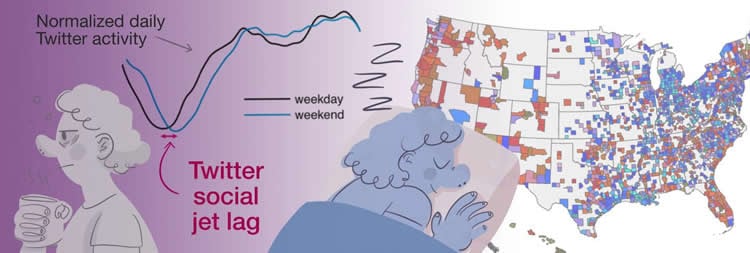Summary: Researchers have managed to find a way to measure social ‘jet lag’, a mismatch between circadian rhythm and the realities of daily schedules, by analyzing patterns of activity on Twitter.
Source: Cell Press.
Social jet lag–a syndrome related to the mismatch between the body’s internal clock and the realities of our daily schedules–has previously been tied to health problems. Now, researchers reporting in Current Biology on November 15 have found a way to measure social jet lag in people all over the country: by analyzing patterns of activity on the social media platform Twitter.
“When we look at how social jet lag changes throughout the year, we find that the dominant effect by far is the social calendar,” says Michael Rust of The University of Chicago. “It suggests that humans in modern societies, at least people who used Twitter in 2013-2014, have biological rhythms that are somewhat disconnected from the changing hours of sunlight throughout the year.”
Previous researchers have measured social jet lag by surveying for differences in wake and sleep times between weekdays and weekends and by using specialized activity monitors. Rust and his colleagues instead simply collected readily available Twitter data for more than 1,500 US counties throughout the 2012-2013 calendar years in 15-minute intervals. Those geographically tagged tweets represented about 240,000 people. The ability to monitor how Twitter activity patterns change season to season and county by county allowed them to separately assess the influences of the socially defined calendar and changes in daylight hours throughout the year.
The researchers found that sustained periods of low Twitter activity were correlated with sleep patterns as measured by conventional surveys. The nightly lull in Twitter activity shifted to later times on weekends relative to weekdays, an indication of social jet lag.
The magnitude of this “Twitter social jet lag” varied seasonally and geographically, with the West Coast experiencing less Twitter social jet lag compared to the central and eastern US. It was also correlated with average commuting schedules, including how many people do shift work, and disease risk factors such as obesity, the researchers report.
Most counties experienced the largest amount of Twitter social jet lag in February and the lowest in June or July. The evidence is consistent with the notion that those patterns are driven primarily by social pressures, including shifting school schedules, and less so by the direct seasonal effect of altered day length.
“For the limited number of counties with unified school schedules for which the calendars are readily available, social jet lag lines up almost perfectly with the calendars, even though the population of Twitter users is clearly not just students,” Rust says. “This is consistent with some studies that suggest that the effect of the sun on our lives may be getting weaker over time, perhaps as we spend more time indoors looking at our phones.”

The new findings help to confirm previously observed trends, including a link between social jet lag and obesity and that people get more sleep on the West Coast. It shows that such trends can be readily studied based on pre-existing data on social media use in place of questionnaires designed to target a specific hypothesis.
In the future, the researchers say they’d like to devise tools to help individual people learn about their body’s internal circadian clock and improve their lives by looking at their own individual timing data. Rust reports that they’re now “thinking about ways to do this.”
Funding: This research was supported by an NIH Training Grant, NIH, a Howard Hughes Medical Institute Faculty Scholar award, the DARPA Big Mechanism program, and by a gift from Liz and Kent Dauten.
Source: Carly Britton – Cell Press
Publisher: Organized by NeuroscienceNews.com.
Image Source: NeuroscienceNews.com image is credited to Olivia Walch.
Original Research: Open access research for “Geographically Resolved Rhythms in Twitter Use Reveal Social Pressures on Daily Activity Patterns” by Eugene Leypunskiy, Emre Kıcıman, Mili Shah, Olivia J. Walch, Andrey Rzhetsky, Aaron R. Dinner, and Michael J. Rust in Current Biology. Published November 15 2018.
doi:10.1016/j.cub.2018.10.016
[cbtabs][cbtab title=”MLA”]Cell Press”Using Twitter to Monitor Social Jet Lag.” NeuroscienceNews. NeuroscienceNews, 15 November 2018.
<https://neurosciencenews.com/social-jet-lag-twitter-10214/>.[/cbtab][cbtab title=”APA”]Cell Press(2018, November 15). Using Twitter to Monitor Social Jet Lag. NeuroscienceNews. Retrieved November 15, 2018 from https://neurosciencenews.com/social-jet-lag-twitter-10214/[/cbtab][cbtab title=”Chicago”]Cell Press”Using Twitter to Monitor Social Jet Lag.” https://neurosciencenews.com/social-jet-lag-twitter-10214/ (accessed November 15, 2018).[/cbtab][/cbtabs]
Abstract
Geographically Resolved Rhythms in Twitter Use Reveal Social Pressures on Daily Activity Patterns
Daily rhythms in human physiology and behavior are driven by the interplay of circadian rhythms, environmental cycles, and social schedules. Much research has focused on the mechanism and function of circadian rhythms in constant conditions or in idealized light-dark environments. There have been comparatively few studies into how social pressures, such as work and school schedules, affect human activity rhythms day to day and season to season. To address this issue, we analyzed activity on Twitter in >1,500 US counties throughout the 2012–2013 calendar years in 15-min intervals using geographically tagged tweets representing ≈0.1% of the total population each day. We find that sustained periods of low Twitter activity are correlated with sufficient sleep as measured by conventional surveys. We show that this nighttime lull in Twitter activity is shifted to later times on weekends relative to weekdays, a phenomenon we term “Twitter social jet lag.” The magnitude of this social jet lag varies seasonally and geographically—with the West Coast experiencing less Twitter social jet lag compared to the Central and Eastern US—and is correlated with average commuting schedules and disease risk factors such as obesity. Most counties experience the largest amount of Twitter social jet lag in February and the lowest in June or July. We present evidence that these shifts in weekday activity coincide with relaxed social pressures due to local K-12 school holidays and that the direct seasonal effect of altered day length is comparatively weaker.






